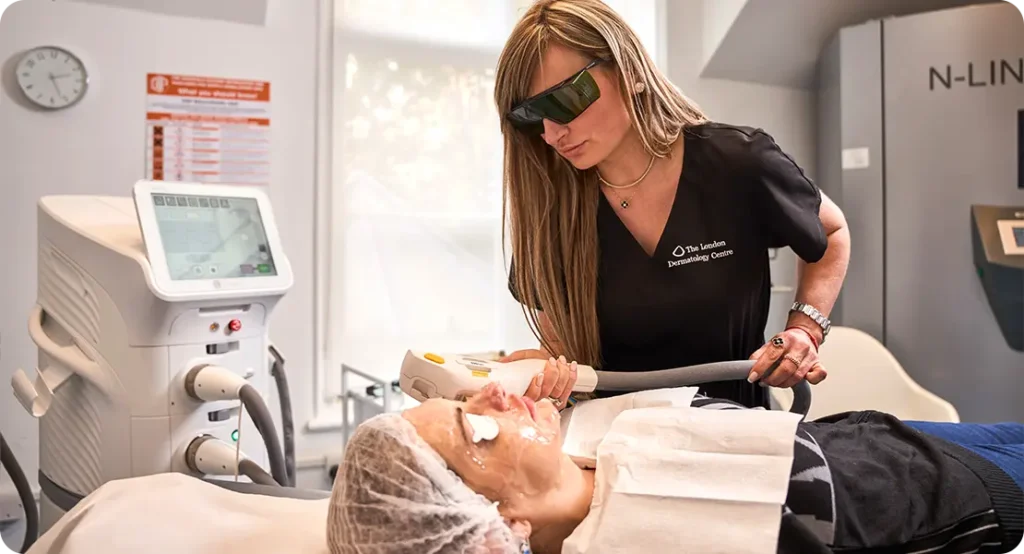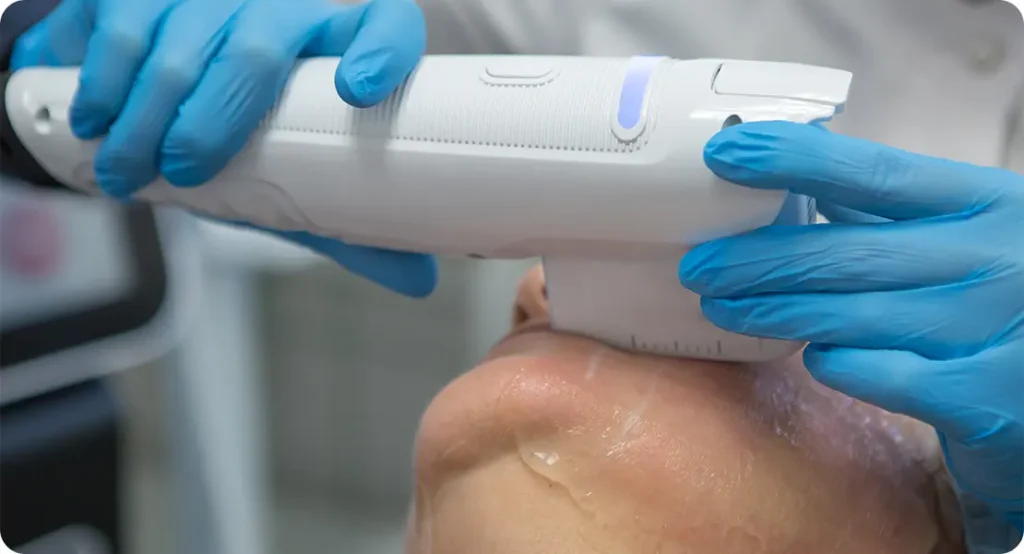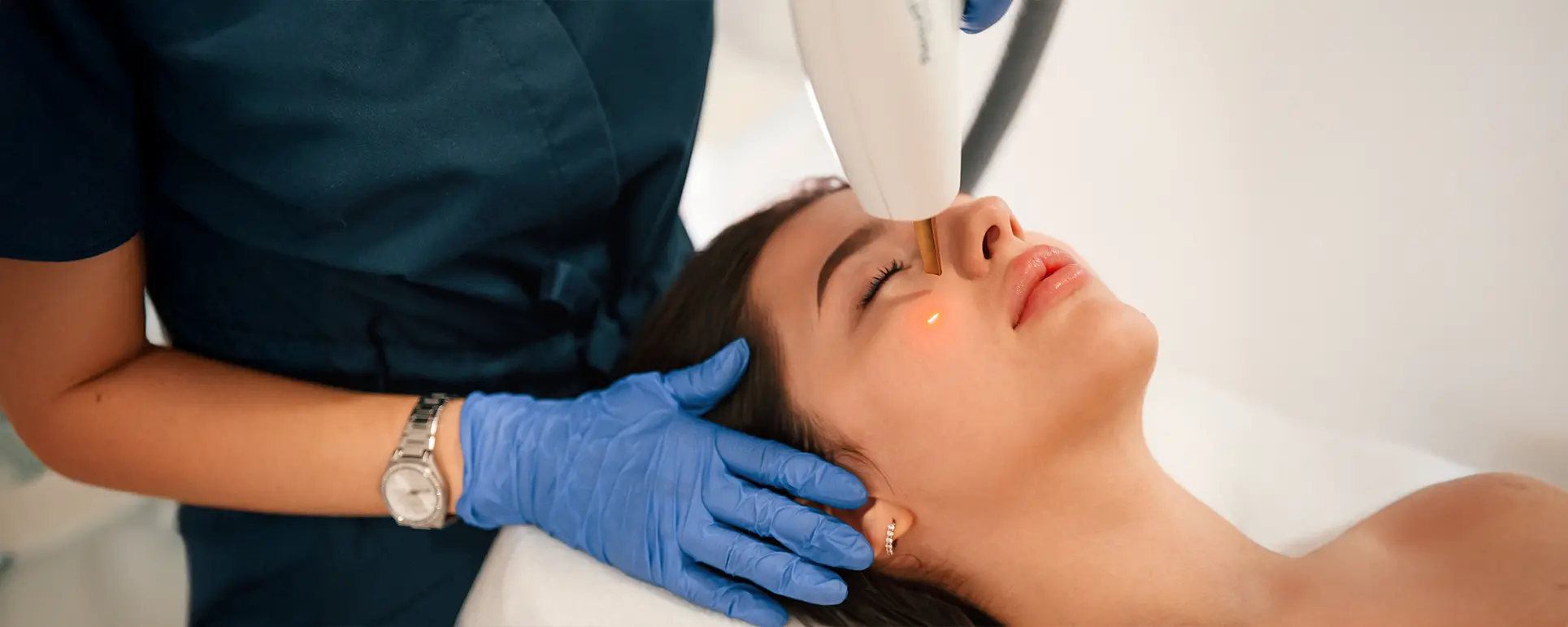Fraxel laser is one of the most popular and effective treatments available for skin rejuvenation, helping to address issues like acne scars, sun damage, fine lines, and uneven skin texture. However, as with any cosmetic procedure, Fraxel laser treatment may not be suitable for everyone.
While the treatment has a proven track record of success, there are certain individuals who may not be ideal candidates. Understanding who should avoid Fraxel laser and why is essential in ensuring that you receive the most appropriate treatment for your skin.
In this guide, I will explain who is not a candidate for Fraxel, highlighting specific conditions, skin types, and health factors that may make this treatment less safe or effective. I’ll also cover alternative treatments that may be recommended for those who are not suitable for Fraxel.
What Is Fraxel Laser?

If you’ve been struggling with uneven skin, fine lines, or stubborn scars, you might have heard about Fraxel laser but what exactly is it, and could it help you? Fraxel is a type of fractional laser treatment that targets your skin with tiny, precise beams of light. These micro-injuries might sound intimidating, but they actually work wonders by triggering your skin’s natural healing process. This means your body starts producing more collagen, which helps your skin repair itself, look smoother, and feel firmer over time.
You can use Fraxel to tackle a range of skin concerns. It’s especially popular if you want to improve:
- Acne scars or dark patches caused by hyperpigmentation
- Fine lines and wrinkles that come with ageing
- Sun damage and age spots
- Uneven skin tone or rough texture
- Stretch marks that have been bothering you
The best part is that Fraxel works gradually, so you’ll notice your skin improving over time giving you natural-looking results instead of something drastic overnight. That said, it’s important to remember that Fraxel isn’t suitable for everyone. Your skin type, medical history, and specific concerns all play a role in determining whether this treatment is right for you.
If you’re curious, the first step is to talk to a qualified dermatologist. They can help you understand how many sessions you might need, what kind of results you can realistically expect, and how to care for your skin before and after treatment.
With the right guidance, Fraxel can help you feel more confident in your skin so if you’ve been looking for a way to refresh your complexion, this might be worth exploring.
Who Should Avoid Fraxel Laser Treatment?

While Fraxel is a highly versatile and safe treatment, certain factors can make it unsuitable for some individuals. Here are the primary groups of people who may not be ideal candidates for Fraxel laser:
1. People with Active Acne
If you’re currently struggling with active acne or frequent breakouts, it’s important to know that Fraxel may not be the best choice for you right now. While Fraxel is amazing at resurfacing the skin and boosting collagen, it works by creating tiny, controlled injuries in your skin. If your skin is already inflamed or has open acne lesions, it may not respond well to the laser and could even react poorly.
Here’s what could happen if you try Fraxel with active acne:
- Inflammation and Sensitivity: Your skin is already sensitive due to acne. Fraxel’s laser energy could aggravate that inflammation instead of improving your skin.
- Risk of Irritation and Scarring: The heat from the laser might make your acne worse, increasing redness and swelling. In some cases, it could even lead to scarring, which is exactly what you’re trying to avoid.
So, what can you do instead?
Don’t worry you still have options. Your dermatologist may recommend starting with treatments that calm and clear your skin first. These could include:
- Chemical peels that help reduce breakouts and unclog pores
- Topical treatments like retinoids or acne-fighting creams
- Oral medications if your acne is more persistent
Once your skin is calmer and your breakouts are under control, you’ll be in a much better position to enjoy the benefits of Fraxel safely. This way, you can get smoother, healthier-looking skin without putting yourself at risk of irritation or further damage.
2. People with Active Skin Infections
If you have an active skin infection, such as a cold sore, bacterial or fungal infection, or flare-ups of dermatitis or eczema, Fraxel isn’t the right choice for you at the moment. While Fraxel can do wonders for skin texture and appearance, it works by creating tiny controlled injuries in your skin. If your skin is already fighting an infection, these micro-injuries can make things worse rather than better.
Why You Should Avoid Fraxel with Skin Infections:
- Fraxel can aggravate infections by creating small openings in your skin.
- These micro-wounds can allow bacteria or viruses to spread more easily, putting you at risk for worsening the infection.
What You Can Do Instead:
Don’t worry you don’t have to put your skin goals on hold forever. Your dermatologist will usually recommend treating your infection first. This might include:
- Topical antibiotics or antiviral creams
- Oral medications if your infection is more severe
Once your skin has healed and your infection is under control, you’ll be in a safe position to try Fraxel. Taking this step ensures that your treatment is not only effective but also safe, so you can enjoy smoother, healthier-looking skin without any complications.
3. People with Darker Skin Tones (Fitzpatrick IV–VI)
If you have darker skin, you can still benefit from laser treatments like Fraxel, but there are a few extra precautions to keep in mind. Darker skin tones (Fitzpatrick types IV to VI) are more prone to changes in pigmentation after laser procedures because the laser interacts with the melanin in your skin. This means you could be at a higher risk of certain side effects if the treatment isn’t carefully tailored for you.
Potential Risks for Darker Skin Tones:
- Hyperpigmentation (dark spots): Your skin may produce extra pigment in response to the heat from the laser, leaving you with unwanted dark spots in treated areas.
- Hypopigmentation (light spots): In some cases, the laser can reduce melanin production in certain areas, causing patches of lighter skin.
What You Can Do Instead:
The good news is there are safer options for darker skin tones. Your dermatologist can help you choose treatments that minimize the risk of pigmentation changes. These may include:
- Lighter laser treatments, such as Nd:YAG lasers, which are gentler on darker skin
- Chemical peels designed to even out skin tone without causing pigment issues
The key is to consult with a professional who can customise your treatment to your unique skin type. By taking the right precautions, you can still achieve smoother, healthier-looking skin without unwanted pigmentation changes.
4. People Who Are Pregnant or Breastfeeding
Fraxel laser treatment is generally not recommended for pregnant or breastfeeding women due to a lack of research on the safety of laser treatments during these stages.
- Hormonal Changes: During pregnancy and breastfeeding, hormonal fluctuations can affect the skin’s response to treatments. This means the results of Fraxel may not be predictable or consistent during this time.
- Risk to the Baby: Although Fraxel is non-invasive, the use of lasers on the body during pregnancy is generally avoided as a precautionary measure.
Alternatives for Pregnant or Breastfeeding Women:
If you’re pregnant or breastfeeding and want to address skin concerns, consult your dermatologist for safe alternatives like topical treatments or gentle skincare routines until you’re ready to undergo laser treatments.
5. People with Severe Skin Conditions (Eczema, Psoriasis)
Fraxel is typically not recommended for individuals with severe skin conditions such as:
- Eczema
- Psoriasis
- Rosacea
Why Avoid Fraxel with These Conditions?
These conditions cause skin irritation, redness, and sensitivity, which can be exacerbated by laser treatments. Fraxel can make these conditions worse by increasing inflammation, potentially leading to flare-ups or new skin issues.
Alternatives for Sensitive Skin Conditions:
People with eczema, psoriasis, or rosacea may benefit from gentler treatments, such as topical steroids or phototherapy, to manage their condition before considering laser resurfacing treatments.
6. People with Certain Health Conditions
If you have certain health conditions, Fraxel may not be a suitable option. These include:
- Diabetes (especially uncontrolled)
- Autoimmune disorders
- Recent surgery or injury in the treatment area
- Blood clotting disorders or the use of blood-thinning medications
Why Avoid Fraxel with Certain Health Conditions?

Fraxel requires your skin to heal and regenerate after the treatment, and individuals with certain health conditions may have a delayed healing process. Conditions like diabetes can impair the skin’s ability to heal, and autoimmune disorders may affect the effectiveness of the treatment.
Alternatives for Health Conditions:
For patients with these conditions, your doctor may recommend non-invasive options, such as topical creams or oral medications, that can help address skin concerns without interfering with your health.
What Happens If Fraxel Isn’t Right for You?
If Fraxel laser isn’t the best choice for your skin, don’t worry you’re far from out of options. There are plenty of other treatments that can give you similar benefits, and a skilled dermatologist can help you decide which one fits your skin type, lifestyle, and goals best. The key is to focus on treatments that improve your skin safely while still delivering results you can see and feel.
Even if you were hoping for Fraxel, the good news is that your skin can still respond beautifully to other approaches. The right alternative can help you smooth out fine lines, reduce scars, and even tone your skin, often with less downtime or risk of irritation. Let’s take a closer look at some of the options you might explore:
1. Chemical Peels
Chemical peels are a long-standing favourite in skin rejuvenation. They work by applying a chemical solution to your skin that gently removes the top layer, revealing fresh, healthier skin underneath. Depending on the strength of the peel, you may see noticeable improvements in texture, tone, and clarity.
- Why You Might Like It: Chemical peels can address a wide range of concerns, from hyperpigmentation and fine lines to acne scars and rough skin. They can leave your skin looking brighter, smoother, and more even over time.
- Who It’s For: Chemical peels can be customised to suit most skin types. If you have darker skin or active acne, your dermatologist will adjust the peel to reduce the risk of irritation or pigmentation changes.
One of the great things about chemical peels is that they come in different depths superficial, medium, and deep so you can choose how intensive your treatment should be. This flexibility makes them a versatile option for anyone looking to refresh their skin.
2. Microneedling
Microneedling is a minimally invasive treatment that stimulates your skin’s natural repair process. Using tiny needles, your dermatologist creates controlled micro-injuries in your skin, which prompts your body to produce more collagen and elastin. Over time, this can lead to smoother, firmer, and healthier-looking skin.
- Why You Might Like It: Microneedling is excellent for reducing fine lines, smoothing out acne scars, and improving the appearance of stretch marks. Many people also notice a glow or improvement in overall skin texture.
- Who It’s For: Microneedling is safe for most skin types, including darker tones. You can also combine it with platelet-rich plasma (PRP) for enhanced results, which can speed up healing and maximise collagen production.
Microneedling is also versatile because it can target multiple concerns in a single session. Whether you’re aiming for reduced scarring, firmer skin, or better absorption of topical products, microneedling can be tailored to your specific needs.
3. Laser Treatments for Darker Skin
If you have darker skin, your dermatologist may suggest pigment-friendly laser treatments such as Nd:YAG lasers. These lasers are gentler than Fraxel and are designed to reduce the risk of pigmentation changes, while still improving skin texture and tone.
- Why You Might Like It: These lasers can treat acne scars, hyperpigmentation, and uneven skin texture without causing dark or light spots. You can achieve smoother, more even skin safely.
- Who It’s For: This is ideal if you have darker skin tones and want noticeable results while minimising the risk of hyperpigmentation or hypopigmentation.
Some of these lasers also allow your dermatologist to adjust the depth and intensity of treatment, so you can achieve a personalised approach that addresses your concerns without over-stimulating your skin.
FAQs About Fraxel Laser:
1. How does Fraxel laser work?
Fraxel laser works by sending tiny, precise beams of light into the deeper layers of your skin. These micro-injuries trigger your body’s natural healing process, which stimulates collagen production and encourages skin regeneration. Over time, this helps to improve the appearance of fine lines, acne scars, uneven skin texture, and sun damage. Unlike more aggressive lasers, Fraxel targets only a fraction of your skin at a time, which allows the surrounding tissue to heal more quickly and reduces downtime.
2. Is Fraxel treatment painful?
Most people describe Fraxel as feeling like a mild to moderate sensation of warmth or tingling on the skin. Your dermatologist can apply a topical anaesthetic beforehand to make the experience more comfortable. Some areas of the face or body may feel more sensitive than others, but the discomfort is generally temporary and manageable. After the session, you may notice some redness or swelling, similar to a mild sunburn, which usually subsides within a few days.
3. How many sessions will I need to see results?
The number of Fraxel sessions required depends on your skin type, the issues you want to address, and the intensity of the treatment. Some people see noticeable improvements after just one session, while others may need a series of three to five treatments spaced several weeks apart. Your dermatologist will assess your skin and create a personalised treatment plan so that you can achieve the best results safely.
4. Can Fraxel be used on all skin types?
While Fraxel is effective for many skin types, it may not be suitable for everyone. People with darker skin tones or certain skin conditions may be at a higher risk of pigmentation changes or irritation. Your dermatologist will evaluate your skin type and medical history to determine whether Fraxel is a safe and effective option for you. In some cases, alternative treatments, such as Nd:YAG lasers or chemical peels, may be recommended instead.
5. What should I expect during recovery?
After your Fraxel session, you may experience redness, swelling, or a mild burning sensation, similar to a sunburn. Your skin may also feel slightly rough or dry as it heals. These effects typically resolve within a few days to a week. It is essential to follow your dermatologist’s aftercare instructions, which usually include using gentle skincare products, applying moisturisers, and avoiding direct sun exposure. Recovery times can vary depending on the intensity of your treatment.
6. Are there any side effects I should be aware of?
Fraxel is generally safe when performed by a qualified professional, but some side effects can occur. Common side effects include temporary redness, swelling, and minor peeling as your skin heals. In rarer cases, pigmentation changes, prolonged redness, or mild scarring may occur, particularly if the treatment is not tailored to your skin type. Discussing your medical history and skin concerns with your dermatologist can help minimise the risk of side effects.
7. Can I combine Fraxel with other treatments?
Yes, Fraxel can often be combined with other skin treatments to enhance results. Many people use Fraxel alongside microneedling, chemical peels, or PRP (platelet-rich plasma) treatments to address multiple skin concerns at once. Your dermatologist will advise on the safest sequence and timing for combining treatments to maximise benefits while reducing risks.
8. How soon will I see results from Fraxel?
Some people notice improvements in skin texture and tone within a week, but the most significant results typically appear gradually over several weeks to months. This is because collagen production and skin regeneration take time. Multiple sessions may be needed to achieve your desired results, and the improvements are usually long-lasting when you follow proper skincare and sun protection routines.
9. Is Fraxel safe for people with medical conditions?
Fraxel may not be recommended for individuals with certain medical conditions, such as uncontrolled diabetes, autoimmune disorders, or skin infections. These conditions can affect your skin’s ability to heal properly or increase the risk of complications. It is important to discuss your full medical history with your dermatologist so that they can determine whether Fraxel is safe for you or suggest alternative treatments.
10. Can Fraxel help with scars from acne or surgery?
Fraxel is particularly effective for treating certain types of scars, including those caused by acne or minor surgical procedures. The laser stimulates collagen production in the affected areas, which can gradually improve the appearance of indentations, texture irregularities, and discolouration. While it may not completely remove deep or severe scars, it can significantly improve their visibility and give your skin a smoother, more even appearance over time.
Final Thoughts: Is Fraxel Laser Right for You?
Fraxel is an excellent treatment for addressing a range of skin concerns, but it’s important to remember that it’s not suitable for everyone. Active acne, skin infections, certain skin types, and underlying health conditions can all affect your eligibility for Fraxel.
If you’re not a candidate for Fraxel, don’t worry there are plenty of other effective treatments available, including chemical peels, microneedling, and alternative laser options, all of which can help you achieve beautiful, rejuvenated skin.
If you’re considering Fraxel laser treatment in London, consult with us at the London Dermatology Centre. Our team of qualified dermatologists will assess your skin, discuss your goals, and recommend the safest and most effective treatment plan tailored specifically for you. With the right guidance, you can enjoy smoother, healthier-looking skin and feel confident in your complexion.
References:
1. Tanzi, E. L., & Alster, T. S. (2008) ‘Fraxel Laser Indications and Long-Term Follow-Up’, Aesthetic Surgery Journal, 28(6), pp. 675–680. This study reviewed the various indications for Fraxel laser and its long-term efficacy in treating photodamage, actinic keratoses, acne scars, and pigmentation disorders. https://academic.oup.com/asj/article-abstract/28/6/675/225729
2. Gold, M. H. (2010) ‘Update on Fractional Laser Technology’, Journal of Clinical and Aesthetic Dermatology, 3(4), pp. 32–39. This article summarised advances in fractional laser technology and its effects on different skin concerns. https://pmc.ncbi.nlm.nih.gov/articles/PMC2921736/
3. Halbina, A., & Alster, T. S. (2014) ‘Fractional Laser Therapy – The Next Step in Alleviating Skin Ageing’, Journal of Clinical and Aesthetic Dermatology, 7(5), pp. 22–28. This paper discussed the role of fractional lasers in rejuvenation and the use of laser therapy for age-related skin issues. https://pmc.ncbi.nlm.nih.gov/articles/PMC4520352/
4. Bass, L. S., & Fitzpatrick, R. E. (2005) ‘Rejuvenation of the Aging Face Using Fraxel Laser Treatment’, Aesthetic Surgery Journal, 25(3), pp. 307–312. This study explored the use of Fraxel laser as a method for treating wrinkles and improving facial skin texture. https://academic.oup.com/asj/article-abstract/25/3/307/228307
5. Friedman, P. M., & Tanzi, E. L. (2022) ‘1550 nm Erbium-Doped and 1927 nm Thulium Nonablative Fractional Lasers: A Review’, Dermatologic Surgery, 48(2), pp. 164–170. This review compared the effects of 1550 nm erbium-doped and 1927 nm thulium non-ablative fractional lasers and summarised their outcomes. https://journals.lww.com/dermatologicsurgery/fulltext/2022/02000/1%252C550_nm_erbium_doped_and_1%252C927_nm_thulium.9.aspx
